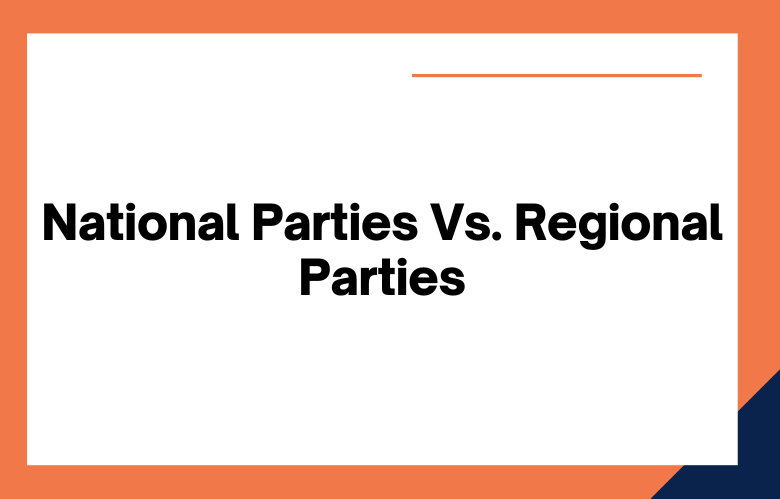India is known for its vibrant democracy, where multiple political parties work towards expanding the country’s opportunities and enhancing the living standards of its citizens.
The playing field has significantly shifted in recent years, with regional political parties emerging as influential players.
These parties have established strongholds in states across India, shaping regional aspirations and impacting national political discourse. It aims to dive into the rise and influence of regional political parties in India.
India is known to be one of the most diverse countries in the world, with many cultures, languages, and identities. Unsurprisingly, the emergence and growth of regional political parties have shaped the country’s political landscape.
With their nuanced understanding of local issues and strong roots in their respective states, these parties have challenged the dominance of national political parties and played a significant role in shaping India’s political future.
What are Regional Political Parties in India?
Regional political parties are organizations restricted to a particular region or state in India. These parties are active in state-level politics and play a crucial role in determining the political landscape of their respective areas.
The emergence of regional political parties in India has significantly developed the country’s political scenario.
These parties represent regional interests and cater to people’s local needs and aspirations.
The regional political parties in India emerged due to various factors, such as the population’s diverse socio-cultural and linguistic diversity, regional imbalances in development, and the need for more localized governance.
These parties have been successful in addressing the issues of their respective regions and asserting their demands at the national level.
Historical Context of Regional Political Parties in India
India is a diverse and complex country with a rich history of regional political parties.
These parties have played a significant role in shaping the country’s political landscape. The emergence of regional political parties in India can be traced back to the 1960s, marked by the rise of linguistic nationalism.
This was when the people of different linguistic communities demanded their separate statehood.
The Dravida Munnetra Kazhagam (DMK), founded in 1949, was one of the earliest and most successful regional political parties.
It was established to promote the interests of the Tamil-speaking people of the southern Indian state of Tamil Nadu. The DMK was instrumental in securing statehood for Tamil Nadu in 1969.
Regional Political Parties and the Indian Political Landscape
Regional political parties play a crucial role in shaping the Indian political landscape, mainly due to the country’s diverse and complex socio-cultural fabric.
These parties primarily represent the interests of specific regions, ethnic groups, and linguistic communities and often place greater emphasis on local issues over national ones. As such, they have the potential to influence and shape the broader political discourse in the country.
One of the key factors contributing to the growth of regional parties in India was the decline of the Congress Party, which had dominated the political arena for several decades.
With the Congress losing its grip on power, regional players emerged and established themselves as credible alternatives, particularly in states where the national party struggled to gain a foothold.
Moreover, the country’s federal structure has also played a pivotal role in enabling these parties to gain prominence, giving them greater autonomy to pursue their regional agendas.
The Strengths and Weaknesses of Regional Political Parties
Strengths:
-More in touch with the needs of their constituents
-More responsive to the concerns of their constituents
-Able to better represent the interests of their constituents
Weaknesses:
-Maybe less experienced than national parties
-Maybe less well-funded than national parties
-Maybe less well-known than national parties
Strengths:
-More flexible and adaptable to change
-Able to respond quickly to issues and concerns
-Closer to the people they represent
Weaknesses:
-May lack the resources of national parties
-May lack the experience of national parties
-Their policies may not be as well thought out as those of national parties
What is the difference between national and regional political parties in India?
National parties in India are those that the Election Commission of India recognizes as having a presence in at least four states.
The Election Commission of India recognizes regional parties in India as having a presence in only one state.
National parties typically have a wider reach than regional parties and are better funded.
Regional parties typically have a more limited reach than national parties and could be better funded.
National parties tend to be more ideologically diverse than regional parties.
Regional parties tend to be more homogeneous in their ideology than national parties.
National parties typically have more big business and industry support than regional parties.
Regional parties typically have more support from small businesses and farmers than national parties.
National party leaders are typically more experienced and better known than regional party leaders.
Regional party leaders typically know local issues more than national party leaders.
How do regional parties impact national politics in India?
In India, regional parties play a significant role in shaping the country’s political landscape.
These parties are usually formed to represent the interests and concerns of a particular state or region, and they often prioritize issues that are relevant to their constituents.
As a result, they can significantly impact national politics by influencing critical policy decisions and legislative outcomes.
One of the primary ways regional parties impact national politics is through their representation in the Lok Sabha, the lower house of the Indian parliament.
With more than 50+ parties represented in the Lok Sabha, regional parties have a significant presence in the political arena. Their influence is often felt in debates and discussions on critical issues.
In many cases, they can use their numerical strength to force the ruling government to make concessions or to block specific bills from being passed.
What are some of the challenges faced by regional parties in India?
Lack of a National Presence:
One of the biggest challenges faced by regional parties in India is that they need a national presence. While there are over 2,000 regional parties in India, most are only active in one or two states.
This makes it difficult for regional parties to impact national politics significantly.
Dependence on Strong Leaders:
Another challenge faced by regional parties is their dependence on strong leaders. Many regional parties are founded and led by charismatic individuals who have a strong following in their home state.
However, if these leaders leave the party or are no longer popular, the party can quickly lose support.
Limited Resources:
Regional parties also tend to need more resources compared to national parties. This is because they rely heavily on donations from local businesses and individuals. As a result, regional parties often need help competing with national parties during elections.
Lack of Name Recognition:
Another regional challenge parties face is that they often lack name recognition outside their home state. This can make it difficult for regional parties to expand their support base beyond their traditional strongholds.
Difficulties Forming Coalitions:
Regional parties also tend to find it difficult to form coalitions with other parties at the state and national levels.
This is because they often have very different ideologies from other parties. As a result, it can be difficult for regional parties to find common ground with other political groups.
Weak Organizational Structures:
Many regional parties also have weak organizational structures, making functioning difficult. This is often because regional parties are founded and led by strong personalities rather than professional politicians.
As a result, there can be infighting and power struggles within regional party ranks, weakening the party as a whole.
Susceptibility to Corruption:
Another regional challenge parties face is that they are often more susceptible to corruption than national parties.
This is because they often rely heavily on donations from local businesses and individuals, which can create opportunities for corruption.
Many regional party leaders are not professional politicians and may need to be more familiar with ethical standards.
Can regional parties form a government on their own in India?
In India’s parliamentary system, the formation of a government requires a party or coalition of parties to secure a majority of seats in the Lower House of Parliament, the Lok Sabha.
While regional parties have gained significant ground in certain states, their ability to form a government on their own at the national level remains limited due to the overwhelming dominance of the two major national parties, the Bharatiya Janata Party (BJP) and the Indian National Congress (INC).
However, in certain instances, regional parties have been able to cobble together alliances with like-minded parties to form a government.
For example, in 1996, the United Front, a coalition of regional and left-leaning parties, formed the government with the outside support of the INC.
Similarly, in 2018, the Telangana Rashtra Samithi (TRS) created a government in Telangana without the support of either the BJP or the INC.
How have regional parties shaped the policies and governance of India?
Regional parties have played a significant role in shaping the policies and governance of India since the early 1990s.
The emergence of these parties was fueled by the desire of various regions in India to gain more autonomy in governance and to address their specific concerns, such as language, culture, and economic development.
The rise of regional parties has challenged the dominance of national parties in India, especially the Congress Party, which had enjoyed a monopoly over Indian politics for several decades.
One of the most notable contributions of regional parties to Indian governance has been the increased focus on regional development.
Regional parties have often championed the cause of their respective regions and lobbied for more significant investment in infrastructure, education, healthcare, and other areas.
This has led to a more equitable distribution of resources and reduced regional disparities in development.
For instance, in the southern state of Tamil Nadu, the provincial party Dravida Munnetra Kazhagam (DMK) has been instrumental in promoting social welfare schemes, such as subsidized food, housing, and healthcare, that have benefited millions of people.
The Future of Regional Political Parties in India
Regional political parties have played a significant role in shaping India’s political landscape. Since independence, India has been governed by a federal system comprising national, state, and local levels of government.
The regional parties emerged in the 1960s and 1970s as a response to the Congress Party’s hegemonic and centralized governance style.
These parties focused on regional issues and became more popular among the voters in their respective states.
The rise of the Bharatiya Janata Party (BJP) in the 1990s also boosted the regional parties.
With the BJP’s focus on Hindutva and the Congress’s decline, regional parties found more significant space in national politics.
Since then, many of these parties have consolidated their position in their respective states and have become essential players in alliance politics at the national level.
However, the future of regional political parties is challenging. One of the biggest challenges they face is the increasing centralization of power at the national level.
The BJP’s dominance in many states and its control over the central government has made it difficult for the regional parties to protect the interests of their respective states.
Many regional parties have been accused of being ‘too soft’ on the BJP or the Congress, raising questions about their ability to stand up for their constituents.
Conclusion:
The rise of regional political parties in India has brought about a fundamental shift in the Indian political landscape.
The federal structure of the country, combined with the regional parties’ grassroots approach, has contributed to their success.
The ability of regional parties to understand local concerns and translate them into meaningful policies has helped them gain traction and a place on the national stage.
The increasing influence of regional parties has also created a more balanced political arena where diverse voices are represented and heard.
In conclusion, the new breed of regional parties is here to stay, and their impact on national politics will continue to be felt in the years to come.
In conclusion, regional political parties have become integral to Indian politics.
These parties have successfully challenged the dominance of national political parties and made significant contributions to India’s political landscape.
While there are concerns about the rise of regionalism, one cannot ignore the fact that regional parties have been able to connect with the people and voice their concerns.
As India continues to evolve, regional parties will likely play a key role in shaping the country’s political future.
Regional Political Parties Rising in India: FAQs
What Are Regional Political Parties In India?
Regional political parties are organizations that primarily operate in specific states or regions of India, focusing on local issues, identities, and governance.
How Do Regional Parties Differ From National Parties?
While national parties operate across multiple states and address national concerns, regional parties concentrate on state-specific interests and contest elections in limited regions.
Why Have Regional Parties Grown In Influence In India?
Due to rising regional aspirations, identity politics, and dissatisfaction with central governance, regional parties have gained strong support bases in many Indian states.
Which Are Some Prominent Regional Parties In India?
Key regional parties include DMK (Tamil Nadu), TMC (West Bengal), Shiv Sena (Maharashtra), BJD (Odisha), TRS (Telangana), AAP (Delhi & Punjab), and JD(U) (Bihar).
What Role Do Regional Parties Play In Coalition Governments?
Regional parties often become kingmakers in coalition governments, especially in hung parliaments, where their support is crucial for forming the central government.
How Do Regional Parties Impact State Politics?
They focus on state issues such as language, culture, regional development, and local governance, often shaping policy at the grassroots level.
Do Regional Parties Influence National Policies?
When regional parties join central coalitions or hold key ministries, they can influence national policy decisions aligned with their state’s interests.
What Are The Strengths Of Regional Political Parties?
Their strengths include deep grassroots connections, an understanding of regional issues, strong local leadership, and the ability to mobilize public sentiment rapidly.
What Are The Weaknesses Of Regional Parties?
Challenges include limited resources, restricted geographical influence, and sometimes excessive focus on parochial issues at the expense of national integration.
How Do Regional Parties Use Identity Politics?
They often leverage linguistic, cultural, religious, or caste identities to mobilize voter support and build loyal constituencies.
How Have Regional Parties Changed The Political Landscape Of India?
They have fragmented the dominance of national parties, increased the importance of coalition politics, and brought regional voices to the forefront of national discourse.
Can Regional Parties Become National Parties?
Yes, with strategic expansion and national issue positioning, some regional parties like AAP have transitioned into national players.
How Do Regional Parties Utilize Media And Technology?
They use local media, vernacular languages, regional influencers, and targeted digital campaigns to effectively reach and influence voters.
What Is The Role Of Regional Parties In Federalism?
They reinforce the federal structure by asserting state autonomy, resisting central overreach, and addressing state-level concerns.
Do Regional Parties Participate In National Elections?
Yes, they contest Lok Sabha elections either independently or as part of alliances, often winning seats that give them bargaining power at the national level.
How Do Regional Parties Mobilize Grassroots Support?
Through local cadre networks, community outreach, social welfare programs, and direct engagement with village-level organizations.
What Is The Future Of Regional Parties In Indian Politics?
As regional identities and issues evolve, regional parties are expected to play a lasting and sometimes decisive role in governance.
How Do Alliances Between Regional And National Parties Work?
These alliances are typically based on electoral arithmetic, mutual interests, and power-sharing agreements before elections or during government formation.
Are Regional Parties More Accountable To Local Issues?
Since their survival depends on regional support, they often prioritize development, governance, and infrastructure issues specific to their constituencies.
Can Regional Parties Influence Presidential Or Rajya Sabha Elections?
Regional parties hold significant sway in the outcome since these elections are based on votes from state assemblies and parliaments.











